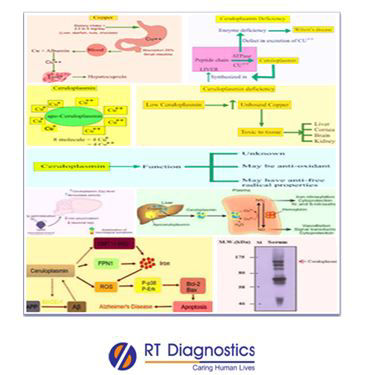CERULOPLASMIN:
Why Ceruloplasmin Test?
CLINICAL INFORMATION
Ceruloplasmin is a glycoprotein synthesized primarily by the liver (and to a lesser extent in other parts of the body such as lung, spleen, bladder, gut, lymph nodes, and adipose tissue in obese people) stimulated by thyroid hormone, and it plays a key role in copper and iron metabolism. Ceruloplasmin is an acute-phase protein hence the level increase during inflammation or inflammatory diseases. In addition, ceruloplasmin acts as an antioxidant, with the ability to remove hydrogen peroxide and lipid peroxidases. It stores and carries copper from the liver to different parts of the body that needs it. The physiological functions of copper are -in the synthesis of melanin, producing energy, forming connective tissues, strong bones, CNS functions, etc. When its level is altered to either too low or too high, it can lead to clinical manifestations of its disorders. The function of ceruloplasmin is the transport of iron apart from copper. At cellular level ceruloplasmin regulates the balance of biogenic amines through its oxidase action on the epinephrine and the hydroxyl-indole metabolisms. Ceruloplasmin test helps primarily to test the levels of copper in the blood and/or urine sample specimens to diagnose certain copper deficiency conditions such as Wilson Disease - a rare inherited genetic disorder caused by a mutation in the ATP7Bgene – since ATP7B protein is involved in exporting copper and 370 different mutations in the gene have been associated with Wilson Disease), is associated with excess storage of copper in the eyes, liver, brain and other organs. Aceruloplasminemia is caused due to absence or very low levels of ceruloplasmin causing the deficiency, hence the levels of copper and iron remains increased due to immobilization, thus leading to high abnormal deposits of iron in the cells - such as pancreas, liver, retina, and basal ganglia of the brain, etc ). The usual causes of copper deficiency are malnutrition and mal-absorption. This test is performed in patients with certain clinical manifestations such as anemia, jaundice, nausea, abdominal pain, trouble speaking or swallowing, tremors, trouble walking, drooling, difficulty controlling moments, and behavioral changes. In infants it manifests as Menkes syndrome – usual symptoms include hair that is brittle, sparse, and or tangled, feeding difficulties, developmental delays, lack of muscle tone and seizures, etc. Other conditions that can lead to low ceruloplasmin are liver disease, kidney disease, gastric surgery, liver fibrosis, zinc supplements (decrease copper absorption), burn injury, hereditary hemochromatosis, Huppke-Brendyl syndrome (mutation in SLC33A1), etc, while higher levels of ceruloplasmin can be a sign of serious infection, heart disease, rheumatoid arthritis, leukemia, and Hodgkin lymphoma. Chronic or neglected cases can lead to tingling sensations in the hands and feet, fatigue, osteoporosis, pale skin, and abnormally low levels of WBCs. Low ceruloplasmin levels can lead to iron overload and neurodegenerative diseases like Parkinson’s disease, Alzheimer’s disease, etc. Ceruloplasmin test is also performed in suspected cases of hemochromatosis (along with other tests such as transferrin saturation, serum ferritin level, and liver function test), and other disorders of copper metabolism. Complications of Wilson's Disease are liver disease or failure, rupture of RBC (hemolysis), neurological and psychiatric disorders. Other tests for Wilsons Disease are conformation of hepato-lenticular degeneration, Kayser-Fleisher rings – a brown discoloration in the outer cornea.

General Instructions:
Sample Requirement: Specimen - Blood sample collected from the vein. Test Preparation: None.
NOTE - Sample for specimen collections may vary based on the patient’s condition/cases according to the patient’s presenting complaints/signs or symptoms:
SPECIMEN REQUIREMENT (Special or Rare Cases) - As instructed and guided by Physician / Clinician / Pathologist / as per Laboratory’s requirements, according to procedures and protocols.
Sample Requirement: Blood Sample taken from the vein
Test Preparation: None
This Multi-Specialty Clinical Referral Laboratory RT DIAGNOSTICS provides precise and accurate tests with an extensive range of testing services to the medical centers to help in the diagnosis and identification of pathology in the test specimens for infectious diseases and also to evaluate the function of organ systems of the patient. It prevents further complications and helps to stabilize and restore health to near normalcy at the earliest without delay.



